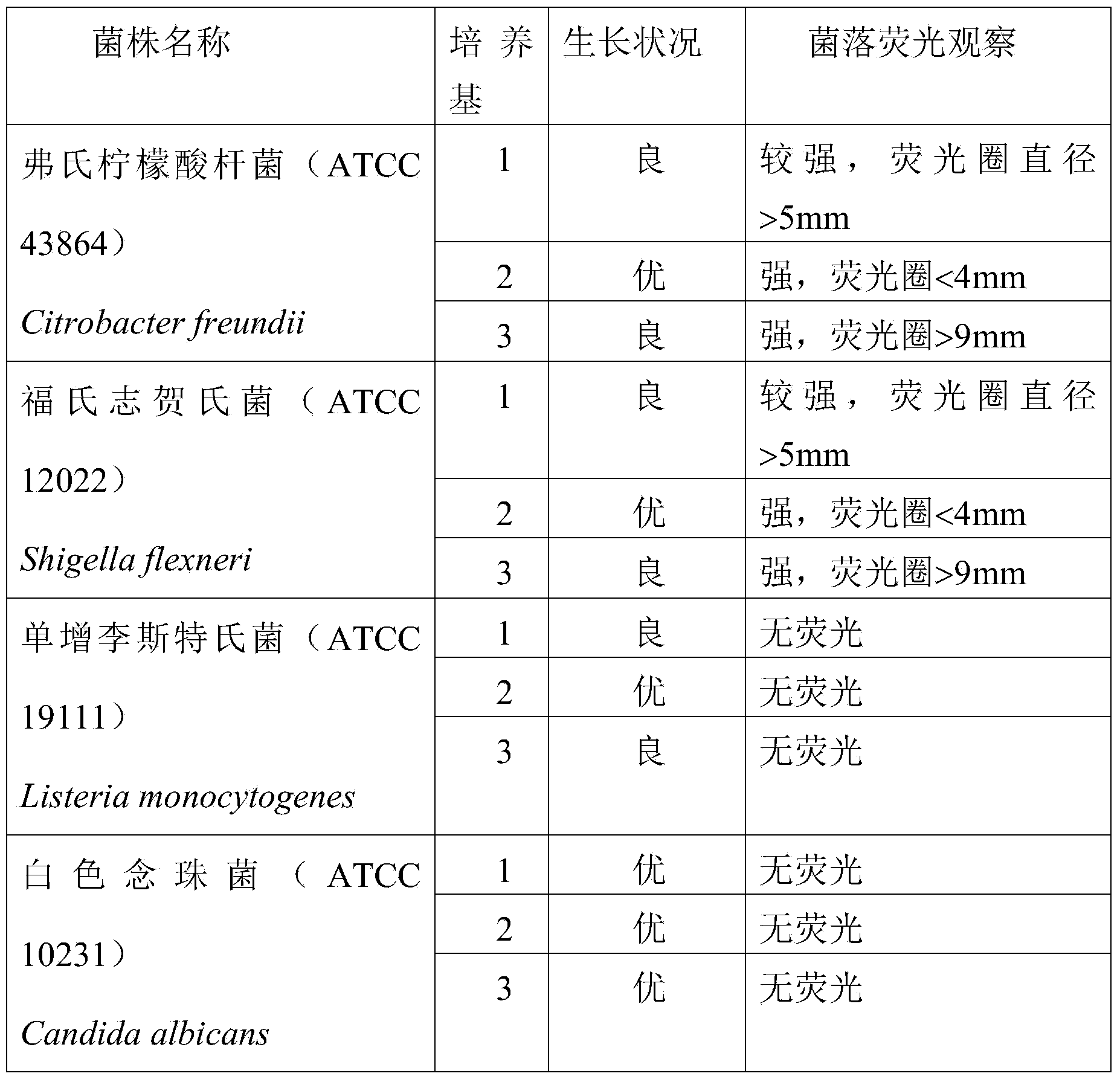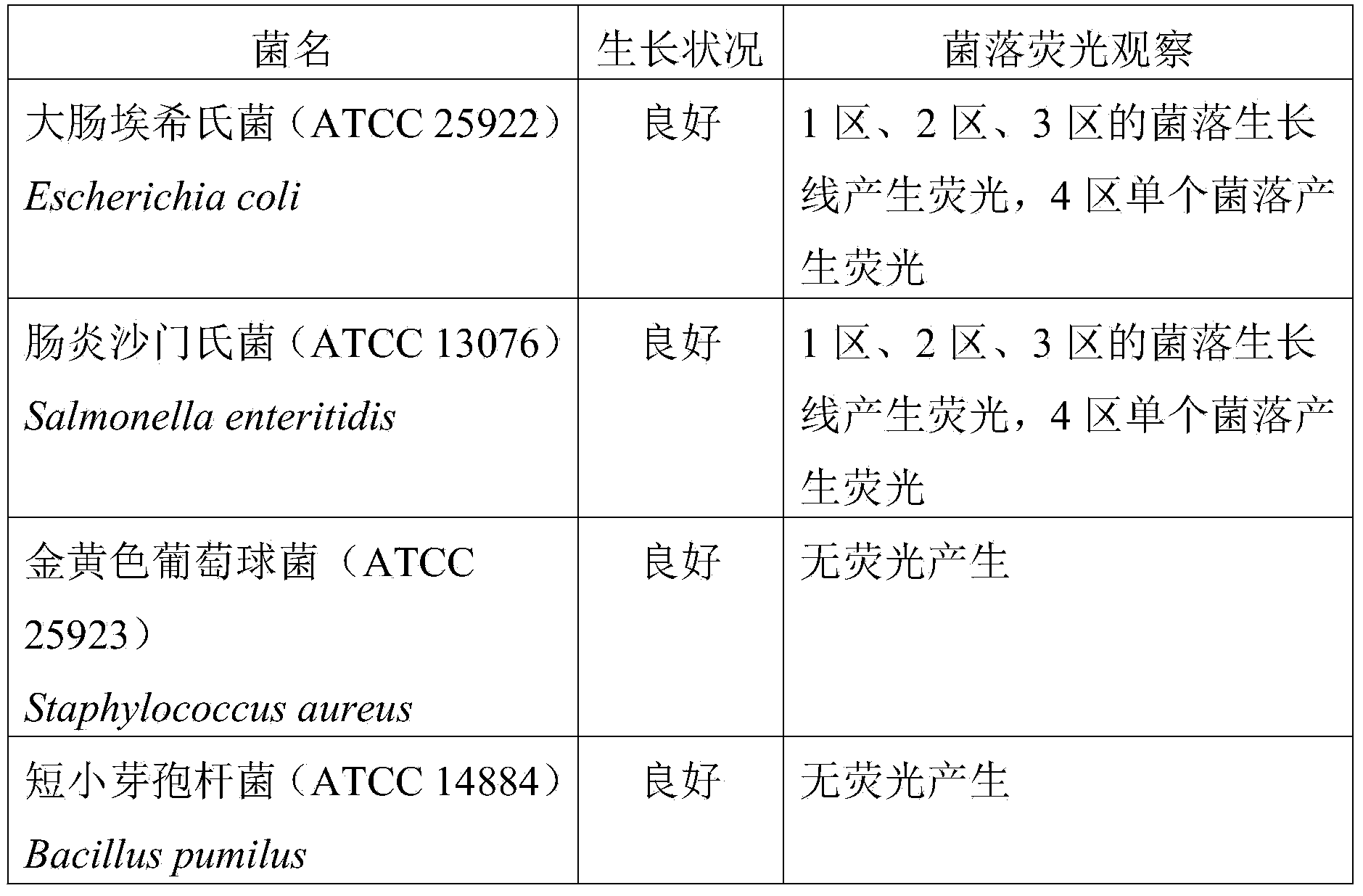Culture medium for identifying gram-negative and positive bacteria and use method
A technology for gram-negative and positive bacteria, applied in the field of culture medium for identifying gram-negative and positive bacteria, can solve problems such as unsolved diffusion problems, and achieve the effects of simple result judgment, strong specificity and unique chemical structure
- Summary
- Abstract
- Description
- Claims
- Application Information
AI Technical Summary
Problems solved by technology
Method used
Image
Examples
Embodiment 1
[0037] Nutritive capacity evaluation and effect observation of embodiment 1 culture medium of the present invention
[0038] (1) Culture medium preparation: Weigh each component according to the formula in Table 1, add each component of the above medium into 1000mL deionized water, stir, heat and boil until completely dissolved, adjust the pH to 6.8±0.2, After cooling to 45-55°C, add L-Alanine-AMC-TFA, mix evenly, pour into a plate, and set aside.
[0039] (2) Inoculation and result observation: Pick fresh pure cultures of the test strains on the plates, prepare them in sterilized saline to a McFarland turbidity of 0.5, take 0.3 mL of bacterial suspensions and spread them on the above plates, and incubate at 36°C After 18 hours, observe whether the colonies produce fluorescence at a wavelength of 365 nm. The experimental strains that produce fluorescence are Gram-negative bacteria, and the experimental strains that do not produce fluorescence are Gram-positive bacteria.
[00...
Embodiment 2
[0045] Embodiment 2 The effect test of culture medium streak inoculation method of the present invention
[0046] Each 1000mL medium contains tryptone 10g, plant peptone 6g, yeast powder 7g, sodium chloride 5g, agar 16g, L-alanine-7-amino-4-methylcoumarin trifluoroacetate 0.1g ( L-Alanine-AMC-TFA), β-cyclodextrin 14g, the balance is water, pH6.8±0.2. Use a sterile loop to transfer the overnight broth culture of the test bacteria to the above-mentioned plate by streaking in four zones, culture at 35±1°C for 18 hours, observe whether the colonies produce fluorescence at a wavelength of 365nm, and produce fluorescence experiments The strains are Gram-negative bacteria, and the experimental strains that do not produce fluorescence are Gram-positive bacteria. Experimental results show that the streaking method for distinguishing Gram-negative and positive bacteria is also applicable to the culture medium of the present invention.
[0047] Table 3. Effect test of streak culture me...
Embodiment 3
[0049] Embodiment 3 The effect of distinguishing Gram-negative and positive bacteria after the culture medium of the present invention is made into a blood plate
[0050] Each 1000mL medium contains tryptone 10g, beef powder 5g, sodium chloride 5g, agar 16g, L-alanine-7-amino-4-methylcoumarin trifluoroacetate 0.1g (L-Alanine- AMC, TFA), β-cyclodextrin 14g, the balance is water, pH6.8±0.2, refer to the blood plate production method, add 60mL of sterile defibrated sheep blood to make a blood plate. After the medical experiment samples are processed according to the national clinical inspection operating procedures or other general methods, they are streaked and inoculated on the plate, cultured at 35±1°C for 18 hours, and observed at a wavelength of 365nm to see if the colonies produce fluorescence. The experimental strain that produces fluorescence is Gram Gram-negative bacteria, and the experimental strains that do not produce fluorescence are Gram-positive bacteria. Experime...
PUM
 Login to View More
Login to View More Abstract
Description
Claims
Application Information
 Login to View More
Login to View More - R&D
- Intellectual Property
- Life Sciences
- Materials
- Tech Scout
- Unparalleled Data Quality
- Higher Quality Content
- 60% Fewer Hallucinations
Browse by: Latest US Patents, China's latest patents, Technical Efficacy Thesaurus, Application Domain, Technology Topic, Popular Technical Reports.
© 2025 PatSnap. All rights reserved.Legal|Privacy policy|Modern Slavery Act Transparency Statement|Sitemap|About US| Contact US: help@patsnap.com



